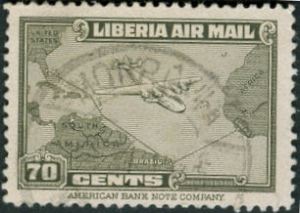Click to see the full-size image


USSR, Scott 2058, 1958, 21mm x 31mm
USSR, Scott 2086, 1958, Litho, 33mm x 21mm
Here is a stamped cover (apparently not a First Day of Issue) featuring two stamps. The map-related one shows a curiously oblate globe at its center. Crouching over the location Moscow prominently marked in red is a number of lines to various destinations, familiar and unfamiliar, including New York, London, Paris, Budapest, Cairo, Ankara, Delhi, Rangoon, Jakarta, Beijing/Peking, Khabarovsk, and Yakutsk. There’s a banner over everything with a Russian inscription I cannot make out, and a TU-104 civil aircraft at its head seeming to streak off into dark blue outer space over North America.
The second stamp from the same year marks 140th anniversary of Karl Marx’s 1818 birth, with the economic philosopher’s dauntingly bushy head reproduced in engraving from the photograph taken of him later in life. Karl Marx famously wrote
A spectre is haunting Europe; the spectre of Communism.
which seems to me to be admirably suited to the other stamp, with its lurid many-tentacled shape brooding over northeastern Europe the way it does.
What a thrill and a sensation it must have been to see this piece arrive from Moscow, by air mail, to the post office at Chagrin Falls (just outside of Cleveland, Ohio) complete with an image of the old revolutionary in dusty rose-red! This was a time shortly Khrushchev ruled Russia as Premier and the Cold War with the United States was made manifest in conflicts all around the world. It was also only a year after the launch of the Sputnik 1 satellite caused a great deal of popular concern about threats to the West from above. And it was not too long after the time of red-baiting had reached its height in the 1950s when a person’s ties to international Communism might cause some serious troubles for them in public.








